
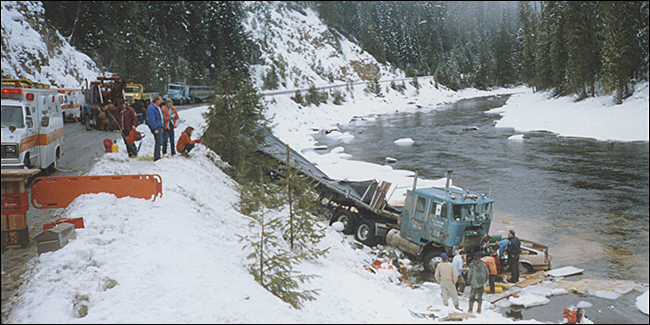
Frame was a Friend of the Lochsa Traveler
![]()
Ron Frame worked for ITD’s District 2 office in Highways from 1986 until taking an early retirement in 2002. Frame, now 75, lives on the outskirts of St. Maries. He was the leadworker for many years in the Powell maintenance shed. In that time, Frame patrolled the Lochsa River corridor on US-12 frequently, and was often the best friend of many a Lochsa Traveler in dire need of assistance.
Here are just a few of those situations:
DRAMATIC RESCUE SAVES WOMAN FROM LOCHSA
lTD maintenance workers do a lot more than simply maintain the highways. Ask Mary Messaros.
Messaros, a 28-year-old Moscow resident, was driving on U.S. 12 along the Lochsa River around noon one day in mid-January 1992 when she attempted to pass a pickup truck pulling a trailer. When she swung out alongside the pickup, she met a semi tractor/trailer head-on. After the semi hit Messaros, it pushed her car 200 feet back down the highway before both her 1986 Chevrolet Cavalier and the semi went off the edge of the highway and into the river.
That's where Frame came in.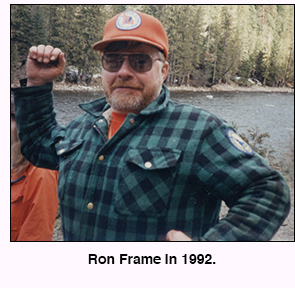
Frame immediately called an ambulance and proceeded to the scene of the accident about 13 miles west of the Powell Maintenance station. He found the two vehicles 15 feet out into the river, and the sedan pinned under the semi in about a foot and a half of ice-cold water. Frame said there was about six inches of ice in the coldest, stillest spots of the river at that time.
Ron, a certified EMT, waded in. He checked the woman's vital signs and collaborated with officials on the scene to plan her extraction from the vehicle. The semi caught on fire while Ron waited. He began scooping up water and throwing it on the fire, before he was handed a fire extinguisher to put out the blaze, which Ron said appeared to start when sparks from the semi’s cables in the battery compartment touched the brake fluid leaking from a rupture. To make the pressure worse, during this time Messaros was begging him not to let her burn up.
Because of the weight of the semi, the roof of the Cavalier had to be cut away, along with other metal. Still, the pressure from the semi kept Messaros' legs pinned under the dash, so that she couldn't be removed. Ron and other EMT's were charged with keeping Messaros conscious and stable during the wait for a wrecker to pull the semi back enough to enable them to remove Messaros.
To call it a strenuous wait vastly understated the case.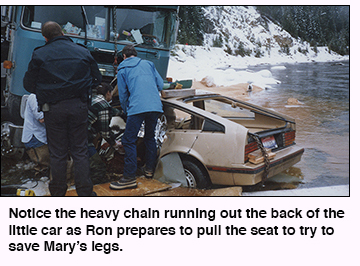
“The EMTs were prepared to cut her legs off in order to get her out of the car and the river. A doctor in Boise who was evidently in charge of the EMTs gave them permission to do so in order to save her. I argued with them from about 11 a.m. to 4:30 p.m. — there was no way I was going to let them amputate her legs. I had a heavy chain and a come-along, and was ready to pull the seat,” Frame recalls.
With daylight dwindling to about a half-hour of light left, they finally relented and let him try to pull the seat off, despite the fear that the immense pressure on her legs was the only thing keeping her from bleeding out.
“I could hear the bolts to the seat popping off, and then it came loose,” Frame recalled.
She was finally cleared from her car and taken via LifeFlight helicopter to St. Patrick's Hospital in Missoula. Despite two broken legs, other broken bones, some abrasions, including one to the head, and her extended exposure to the freezing water, Messaros was reported to be in fair condition. No hypothermia was found.
Messaros went to the Forest Service office to thank those involved, but Frame never saw her again. "We all do what we can and, hopefully, some recover and live full and happy lives," said Frame.
Frame's performance in this emergency was above and beyond the call of duty. And the fact is, this sort of action is not unheard of among the ranks of ITD maintenance workers. These are men and women taking pride in their accomplishments with an earnest desire to do all that is necessary to help.
Note: There is a 55-year-old Mary Messaros now living in Washington. According to her bio, she is formerly of Moscow and is the right age, so one assumes it is her. She did not respond to attempts to contact her.
BEE CAREFUL: ITD EMPLOYEES SAVE TRUCKER
Responding to emergencies on U.S. 12 wasn't that unusual for Frame. But a May 31, 2001 semi truck crash near the Wilderness Gateway northeast of Lowell was a uniquely stingy situation for the Powell maintenance leadworker. The driver was pinned in the cab, along with millions of angry, swarming bees — 480 hives worth.
"It was black with bees and they were mad," said Frame. "When I walked to the truck, about 1,000 to 5,000 bees hit me. We didn't dare quit, because the truck driver was getting stung, too."
Most of the lTD employees and police who responded to the accident were allergic to bee stings, or at least said they were to avoid wading into the chaos.
An lTD truck was the first on the scene of the crash in the early afternoon. The truck's crew immediately began directing traffic through the area, asking drivers not to pull over and to keep their windows rolled up because of the bees.
News of the accident was radioed to Frame and Parsells as they were performing maintenance work on ditches along US-12. After driving about 20 miles to the crash scene, they suited up as best they could in gloves, hoods and bags with eye holes cut out, and moved in to help.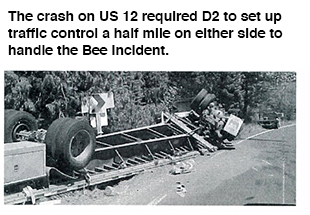
After the front window was removed, Frame crawled in with the driver to release his leg, which was pinned between the steering wheel and seat. Foreman Rod Parsells worked outside the cab of the truck to saw off the steering wheel and pull the seat off the driver's leg using a 2 ½-ton winch. The joint effort of Frame and Parsells freed the driver in about an hour with a cut finger, badly bruised leg and a few stings. He was taken to a waiting LifeFlight helicopter and airlifted to a Montana hospital.
Frame said he was stung all over his head and hands, but that Parsells got the worst of the stinging because he was working outside the cab of the truck, while Frame worked inside the cab, near the floor, during most of the ordeal. Parsells received about 50 or 60 stings to the head.
"It wasn't the first time I've had to get a guy out of the semi, but it was the first one with a bee truck," said Frame. "Bees got between my glasses and my eye and I thought. 'please sting me in the eyelid, not in my eye.’ While both men had a very painful weekend. Frame said neither had to go the hospital.
Frame said his four years of experience as an emergency medical technician helped the duo fig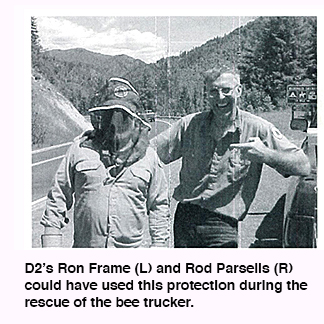 ure out a strategy to get the driver out by removing the seat.
ure out a strategy to get the driver out by removing the seat.
lTD maintenance crews are often the first on the scene of car and truck wrecks on remote stretches, where access to police and medical services can he more than 100 miles away.
Frame said that in his career he helped out at emergencies at least once a month and that helping state police was second nature and part of the job, not heroism. "We worked closely with ISP. Generally, we helped out with traffic control first and then looked to see if there was any other assistance we could offer."
"We did it because it had to be done and nobody else could do it. That trucker was as close to the middle of nowhere as you can get," said Frame.
Frame and Parsells went to Coeur d’Alene later that year to get an award from the Idaho Transportation Board. Frame had estimated that there were about 1,000 to 2,000 bees per hive – nearly half a million bees in all. He was corrected by a board member who raised bees in southern Idaho, crunched the numbers, and calculated there had been at least 9.6 million bees at the scene!
The photos below are from just a few of the dozens of rescues Frame responded to in his years with ITD. The Lochsa was the backdrop for most of them.
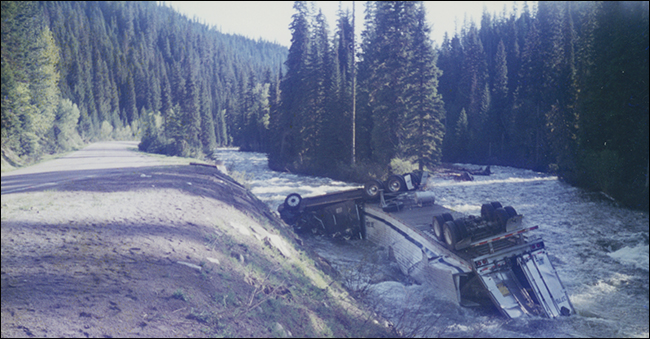
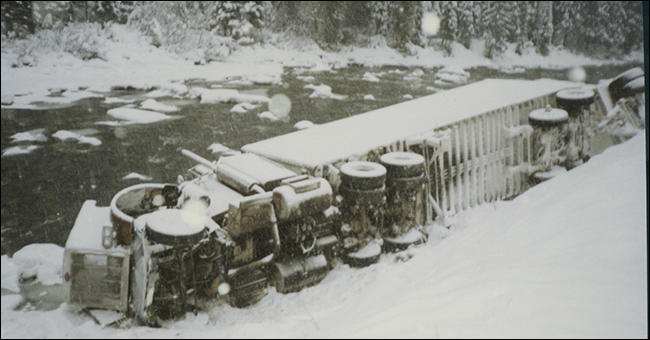
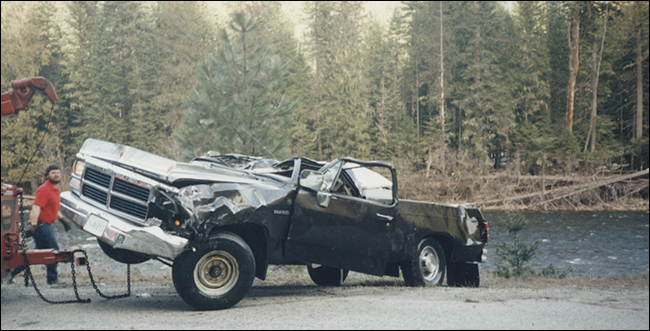

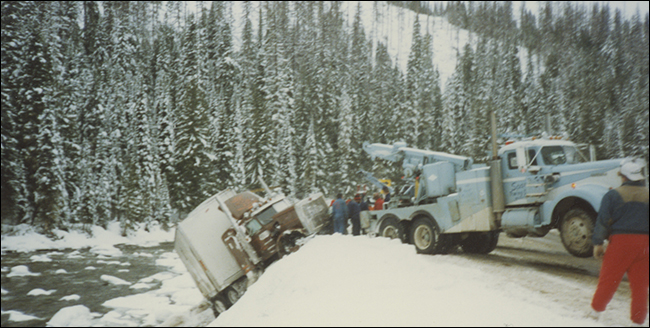
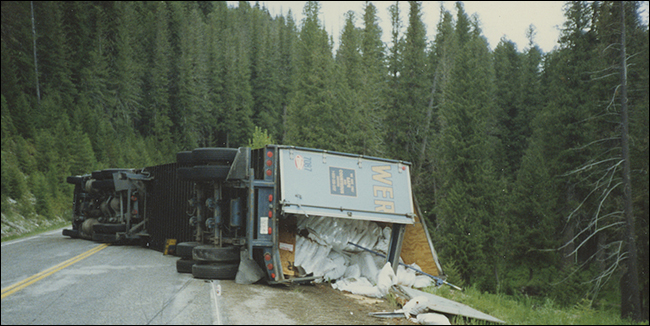
Published 06-07-19